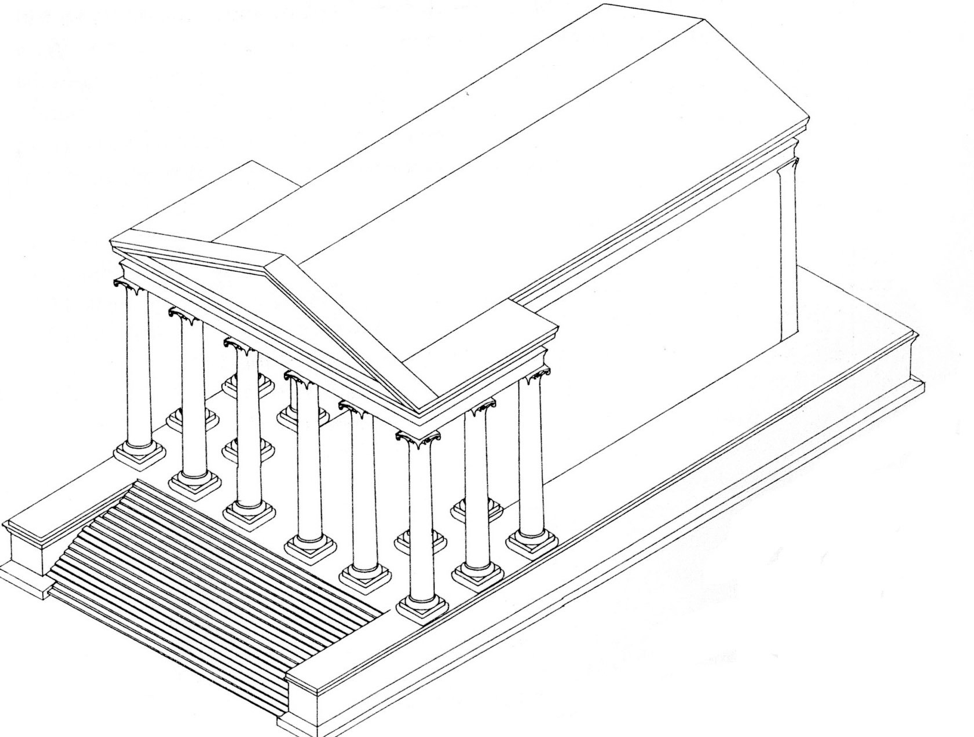
The Amman Citadel, located in the heart of modern-day Amman, is an impressive site that helps tell the story of this region’s layered heritage. It is also the site of one of ACOR’s most impactful undertakings to date: the excavation and partial restoration of the Great Temple of Amman, also known (inaccurately) as the Temple of Hercules.
Central to Amman, the Citadel dominates one of the seven jebels—or hills—that make up the capital city of Jordan. Known locally as Jebel al-Qal’a, the site boasts the remains of a Roman temple, a Byzantine church, and an Umayyad palace, along with several other features of historical interest. The Citadel’s Roman temple, the Great Temple of Amman, was one of the principal monuments of Amman during the classical period. An inscription dates the temple’s construction to the term of the Roman governor Geminius Marcianus (A.D. 161–166). The restored columns and bases, which notably stood only at the front of the temple (and not also along the sides as they did in some other Roman temples), measure 13.5 meters (45 feet) tall. The ancient architects, and modern restoration team, had to stack five or six column drums, each weighing up to 11 tons, to create, or re-create, each column. The temple rose from a podium 43 by 27 meters (141 by 88 feet), which is somewhat less than half the size of a soccer field. In addition, a colossal marble hand and elbow, fragments thought to be the remains of a Roman statue of Hercules that once stood 13 m tall, have been found near the temple. All of these measurements suggest that, in size, this temple may have rivaled many of those in ancient Rome.
The Citadel witnessed the rise and fall of several different empires, among them the Assyrians, Babylonians, Romans, and Umayyads. It has attracted the interest of archaeologists from the early 20th century onward, including excavations by Italian archaeologists begun in 1930. The Jordan Archaeological Museum was built near the temple site in the early 1950s. ACOR Annual Professor Rudolph Dornemann conducted excavations at the Citadel in 1968–1969 as part of training excavations with the Department of Antiquities, which was the start of ACOR’s work in central Amman. In 1989–1990, Dornemann, with archaeologists and architects from the University of Jordan, developed the Amman Citadel Feasibility Study. In 1990, the Temple of Hercules Project was initiated.
Excavations of the temple and its temenos (the wall surrounding its sacred precinct) led to the exposure of buried architectural fragments. The excavations were conducted under the auspices of ACOR and the Department of Antiquities, on behalf of the Ministry of Tourism and Antiquities of Jordan between 1990 and 1993. There were a number of co-directors and directors of the excavations, and contributors to the final report, including Mohammed Najjar (Department of Antiquities), Kenneth W. Russell (ACOR), and Ahmed Momani (University of Jordan). Anthi Koutsoukou contributed to and completed the final report of the excavations.


In 1991, ACOR set out to initially document architectural fragments and then to partially restore the architecture of the Roman temple. Under the supervision of Chrysanthos Kanellopoulos of the University of Athens and Jordanian engineer Mohammed Tayyem, this restoration project was implemented thanks to funding from the United States Agency for International Development (USAID).
The project documented the architectural elements of the temple and partially revived its ruins. Most of the original stones of the temple had been removed and reused prior to earthquake activity in the mid-8th century, at which point the rest of the building and four remaining columns collapsed. More of the stones were removed over subsequent centuries. In the restoration efforts of 1992, three newly quarried and carved column drums were added to help visitors visualize the temple, and in 1993, a 16-ton architrave (beam) was added atop two of them. Given the partial nature of the remains, it is remarkable that three of the Great Temple’s columns could be restored, establishing the Citadel as a new icon of the Jordanian capital’s skyline. Representing a thriving heritage that spans millennia, the site today serves as a monumental tribute to Amman’s ancient past.
ACOR also focused on Islamic architecture at the Citadel. An Ayyubid tower, constructed in the late 12th to early 13th centuries A.D., makes up part of its fortifications. Built mainly from stones form the Great Temple, the tower was a one-room structure with arrowslits for archers. Because part of the monument was in danger of collapse, ACOR restored it in 1996.
For more details, see:
Kanellopoulos, Chrysanthos. 1994. The Great Temple of Amman: The Architecture. Amman: ACOR.
Koutsoukou, Anthi, Kenneth W. Russell, Mohammad Najjar, and Ahmed Momani. 1997. The Great Temple of Amman: The Excavations. Amman: ACOR.
Russell, Kenneth W. 1991. “Excavating and Rebuilding the Temple of Hercules.” ACOR Newsletter 5: 1–5.

The Great Temple of Amman – The Architecture

